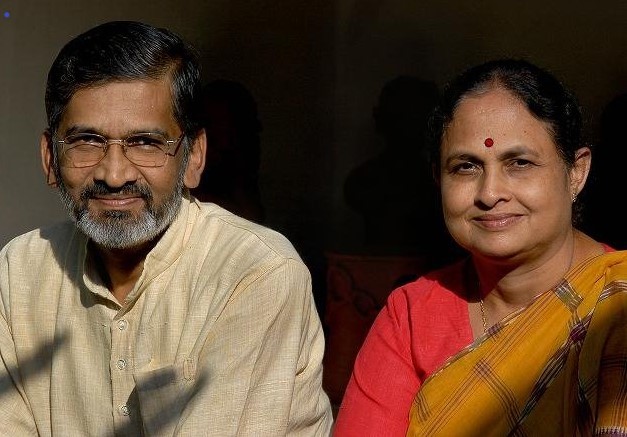New born care in resource poor setting: Dr Abhay and Rani Bang give you solutions
M3 India Newsdesk May 02, 2018
A peek into the humongous body of work of Dr. Abhay and Dr. Rani Bang, the pioneers of home-based newborn care, a revolutionary strategy to save lives of newborn children in areas where the healthcare systems are weak.

This year’s Padmashri awardees, Dr. Abhay and Dr. Rani Bang are a couple who have made a deeply significant impact on rural healthcare across the world. They are the pioneers of home-based newborn care, which is a complete package in itself that also includes management of sepsis (septicaemia, meningitis, pneumonia), to save lives of newborn children in areas where the healthcare systems are weak.
An upsetting incident occurred in their lives when they were working in Gadchiroli, Maharashtra. A weak, emaciated child came to their clinic, his mother having fought broken bridges, thorny forests, and a defunct village health care center to get him there. The child could not be saved. This shocked the Bang couple, and they decided to train women health workers who would save children in their own villages.
Thus was born the concept of home-based newborn care.
The concept
Simplifying the diagnostic criteria for birth asphyxia
Dr. Bang simplified the diagnostic criteria for birth asphyxia, which was diagnosed at a minute after birth
- The health workers were trained to clear mucus with an oral mucus trap, tactile stimulation, and artificial respiration
- Birth weight measurement was conducted, and low birth weight children who were at greatest risk were managed by various practices such as constant breastfeeding, keeping the child warm and dry and treatment with oral acetaminophen
- Hand-washing, keeping the surroundings clean, and encouraging overall hygiene
However, infectious conditions such as pneumonia, sepsis and septicaemia still persisted, and the globally recommended practice of taking a child to the hospital was simply not possible for most infants born in areas as remote as Gadchiroli, where hospitals were nowhere near their villages.
Simplifying the diagnostic criteria for infectious conditions
Dr. Bang simplified the diagnostic criteria for detecting infection in the newborn.
The criteria were:
- if a baby’s cry became weak or abnormal or stopped,
- if a baby stopped sucking or the mother felt that the sucking had definitely become weak or reduced,
- if the baby became drowsy or unconscious,
- if skin temperature was more than 99°F (37·2°C) or less than 95°F (35·0°C),
- if there was pus in the skin or umbilicus,
- if the baby had diarrhoea or persistent vomiting or distension of abdomen,
- presence of grunting or severe chest indrawing,
- and if a respiratory rate 60 or more per min was seen in a quiet baby even after two counts, the baby was diagnosed to have an infection.
A solution for a resource-poor setting
The couple then developed a simple treatment protocol
Oral administration of co-trimoxazole, twice a day for a week and a Gentamicin injection to be given by the trained women health workers.
While this practice was deemed controversial at first, a team of paeditricians from the All India Institute of Medical Sciences examined the SEARCH women health workers team and certified that they were administering these injections with due care and precautions. In 1991, the WHO and UNICEF acknowledged this as one of the best ways to treat neonatal pneumonia and it was recommended that health workers across 77 countries be trained to use this method. Moreover, in 1989, when the study was published, the approach cost only US$5.3 to save a child, infinitely cheaper than the advanced medical centers and nearly as effective in resource-poor settings.
This treatment worked miracles and some of his Arogyadoots (health ambassadors) have saved lives of children which can be deemed critical even by modern medical standards. Dr. Bang’s approach reduced infant mortality from 121 deaths per 1000 live births to 30 deaths per 1000 live births. After his spectacular success at creating such a revolutionary method of treating newborns in rural areas, Dr. Bang conducted replication studies across Maharashtra and later in India, which too was successful.
A few years ago, the Government of India introduced the Accredited Social Health Activist, or ASHA workers program, whose roles are similar to Dr. Bang’s Arogyadoots. More than 800,000 ASHAs now work in India’s villages, acting as barefoot doctors where conventional hospital-based care cannot be accessed by the rural citizens of India.
Along with child health, SEARCH has conducted pioneering research in infectious diseases such as malaria, women’s health, the impact of alcohol on health, and are now working on non-communicable diseases and other important issues such as mental health in rural areas of India.
The couple has been a recipient of many awards.
- Macarthur award for creative and effective institutions
- Maharashtra Bhushan Award, given by the Maharashtra Government to remarkable achievers from Maharashtra
One of the couple's papers has made it into a prestigious selection of papers published in The Lancet, titled ‘Vintage Papers from the Lancet’, which include revolutionary discoveries including the use of stethoscopes, blood groups, Pasteur’s germ theory among many others.
TIME magazine has also hailed them as one of the ‘Global Health Heroes’ in a 2005 issue.
-
Exclusive Write-ups & Webinars by KOLs
-
Daily Quiz by specialty
-
Paid Market Research Surveys
-
Case discussions, News & Journals' summaries
